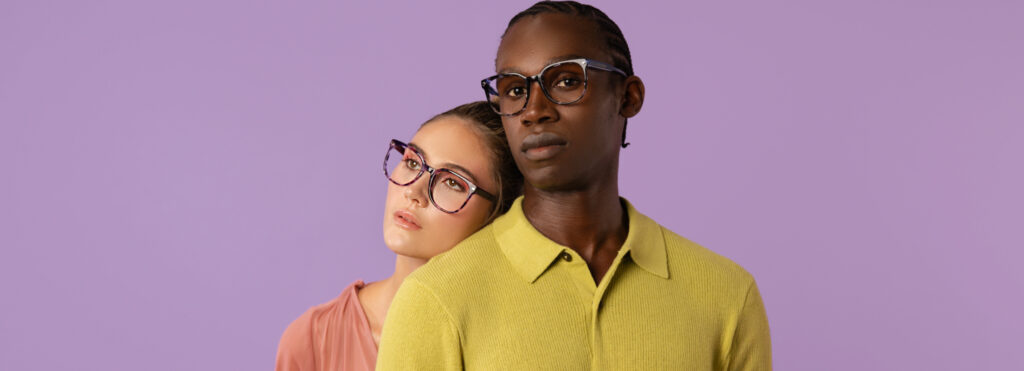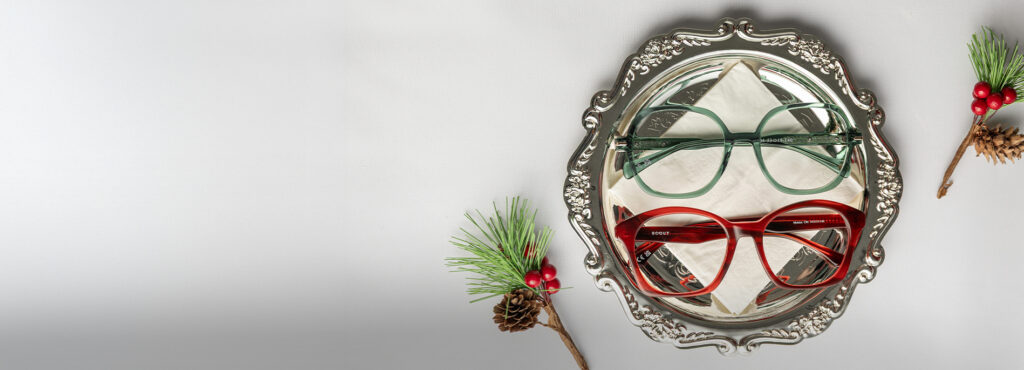Our eyes are one of our most defining features and often the first thing people notice. While brown, blue, hazel, and green are the most common, there are also less familiar eye colours that you might not think of straight away.
So, what exactly is the rarest eye colour? Surprisingly, green eyes are one of the least common and in rare cases, people can even have red, purple, or pink eyes. In this post, we’ll explore unusual eye colours, what causes them and how to choose glasses that make your eyes stand out.
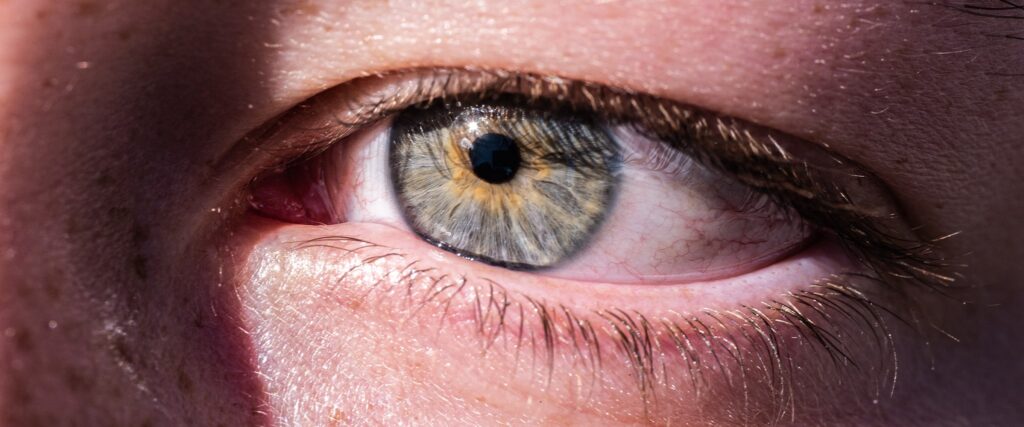
Understanding eye colour genetics
Colour variations in the human eye are caused by the levels of melanin in the iris (the coloured part of the eye). Melanin also influences your hair and skin tone.
- More melanin = darker eyes (brown, dark hazel, deep amber)
- Less melanin = lighter eyes (blue, green, grey)
Brown eyes have melanin on both the back and front part of the iris. Even light blue eyes contain a hidden brown pigment on the back, but their appearance comes from the way light scatters in the iris. Genetics, especially variants in the OCA2 gene, also influence pigmentation and play a major role in determining your eye colour.
Did you know? Darker eyes naturally provide more protection against bright light and blue light, while lighter eyes may be more sensitive. Lighter shades may also appear to change colour depending on lighting conditions.
What is the rarest eye colour?
Most people globally have brown eyes. Around 1% of the world’s population has the most unusual eye colours. However, deciding which exactly is the rarest eye colour can be difficult, especially as rare shades are often linked to genetic mutation or rare medical conditions. The table below displays the approximate percentage of the world’s population who have each of the different eye colours.
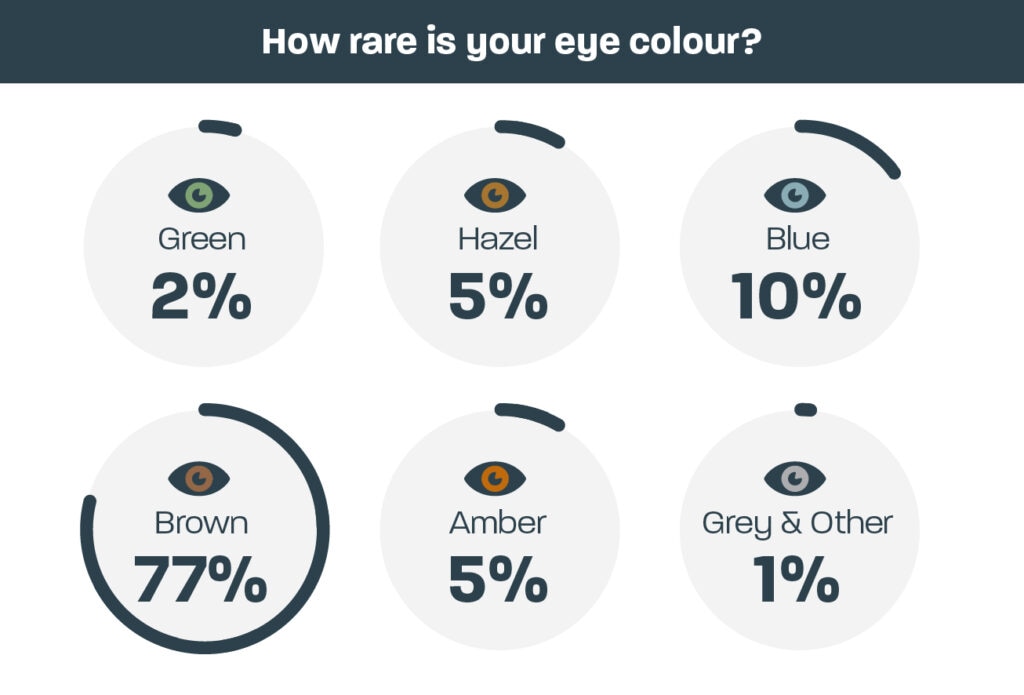
Top 5 rarest eye colours in the world
Red eyes
Commonly linked to albinism, eyes can appear red or pink due to a lack of pigment in the iris. This happens because blood vessels under the surface are more visible.
Violet eyes
Violet or purple eyes do exist, but they’re extremely rare, usually found in people with albinism where melanin levels are very low. The Hollywood legend Elizabeth Taylor was rumoured to have a violet eye colour, though her striking appearance was more likely due to light conditions and makeup which enhanced the natural vibrant blue of her eyes.
Grey eye colour
Grey eyes are often mistaken for other light eyes like blue, but they contain subtle brown flecks and more collagen which scatters light in the stroma, giving them a cloudy, misty appearance.
Green eyes
Green eyes are one of the most unique eye colours, ranking just after grey, red and violet. Green eyes reflect light through a process known as Rayleigh scattering — the same effect that makes the sky look blue. Combined with a yellowish pigment called lipochrome, this creates a green appearance.
Amber eye colour
Amber eyes are golden or coppery in colour, caused by higher levels of lipochrome. They’re often confused with hazel, but amber eyes are different because of their uniform colour.
Hazel eyes
Hazel eyes are most commonly a mix of brown, green and gold. This happens due to the amount of melanin in the iris, which sits between that of darker brown eyes and lighter green eyes. This, combined with the scattering of light, creates their multi-tonal effect. Often, hazel eyes have green or golden flecks that make them appear especially distinctive and vibrant.
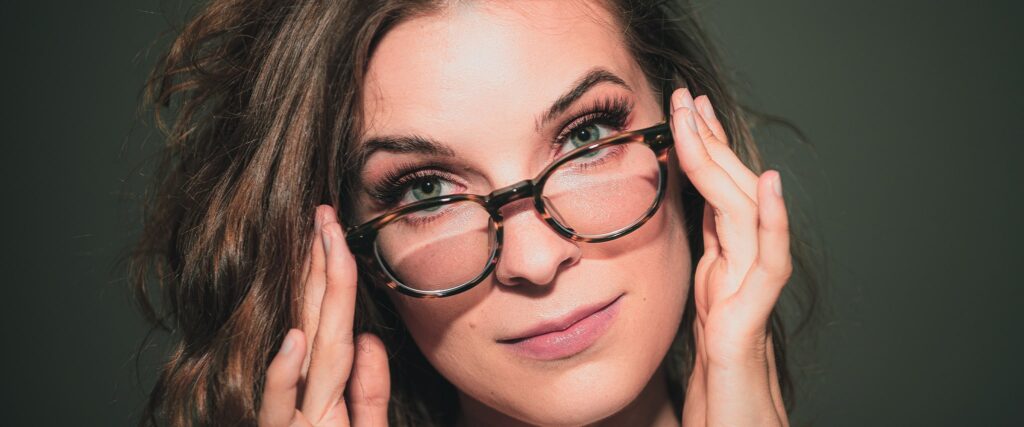
The most common eye colours
Brown eyes
Brown eyes are the most common eye colour worldwide, ranging from light brown to almost black in some lights. High melanin levels offer natural UV protection. Despite this, studies have shown that people with dark-brown eyes may face a higher risk of cataracts. However, it’s important to be aware that everyone, no matter their eye colour, still benefits from UV-blocking eyewear.
Fun fact: It’s a myth that all babies have blue eyes. The truth is, many are born with brown eyes!
Blue eyes
Blue eyes don’t actually contain blue pigment. Their colour comes from light scattering in the iris. With less melanin, they can be more sensitive to sunlight and at higher risk of certain eye conditions like age-related macular degeneration, cataracts and ocular cancer. Sunglasses with 100% UVA/B protection are a must.

What factors can affect your eye colour?
Certain rare eye colours and eye colour changes can be linked to eye health or genetic conditions:
Glaucoma — High eye pressure that can damage the optic nerve and affect vision if left untreated.
Heterochromia — A rare condition where an individual has different-coloured eyes, for example one blue and one brown eye.
Anisocoria — Unequal pupil sizes, sometimes altering eye appearance.
Albinism — Lack of melanin, leading to very pale eyes (blue, red, or pink).
Cataracts — Clouding of the lens, making eyes appear whitish grey.
Horner Syndrome — Causes a drooping eyelid, a smaller pupil and can sometimes make one eye appear lighter than the other.
Hyphema – Blood in the front of the eye after injury, making the iris look red. This condition is normally caused by sports injuries.
Uveitis – Inflammation that causes redness. This can be caused by infection, toxins or a sports injury.
Arcus senilis – A grey or white arc of fatty deposits around the cornea, linked with ageing and high cholesterol.
What glasses suit your eye colour?
Brown, hazel or amber eyes pair beautifully with earthy tones, brown, green, tortoiseshell, gold or even blue or purple.
Blue eyes contrast well with oranges or reds and harmonise with transparent, blue, silver or grey hues.
Green eyes work nicely with dark brown, Havana, gold and transparent frames. They also contrast well with colours like pale pink, blue, or violet.
Grey eyes pop against pastel shades, bright patterns and gradient-coloured frames as well as bold black, or dark blue and deep purple frames.
Can you change the colour of your eyes?
If there’s a certain eye colour you’re keen to try, coloured contact lenses let you experiment and try a whole new look, whether you’d like to see yourself with grey, green, or even purple eyes.
Final thoughts
Whether your eyes are brown, blue, hazel, or something rarer, they deserve the right frames to make them shine. At Glasses Direct, you can explore hundreds of styles, so you’ll always find the perfect pair to complement your eyes.


